How to Make an Air Freshener for Cars?
Table of Contents
how to make a air freshener for cars? hits the mark. Store-bought fresheners often smell fake or fade fast—but making your own? It’s cheaper, natural, and dead easy.
From mason jars to felt cut-outs, Aussies are getting crafty with their car scents. “Essential oils can lift your mood and clean the air at the same time,” says local aromatherapist Tanya Hill. That’s a win-win when you’re stuck in peak-hour traffic.

This guide gives you the tools and ideas to keep your car smelling schmick—plus a few clever hacks you probably haven’t tried. Let’s dive into the top types of DIY car air fresheners and find one that fits your vibe.
Car Air Freshener Types
Car air fresheners come in all shapes and styles — pick what suits your ride and keeps bad odors in check.
Hanging Card Freshener Shapes
Classic and cheap, cardboard fresheners hang neatly from your rearview mirror. They come in tree, star, or custom shapes soaked in fragrance oil. Swap them monthly to keep your car smelling schmick. “Simple, old-school and still a winner for budget drivers,” says Aussie car detailer Mick Rogers.
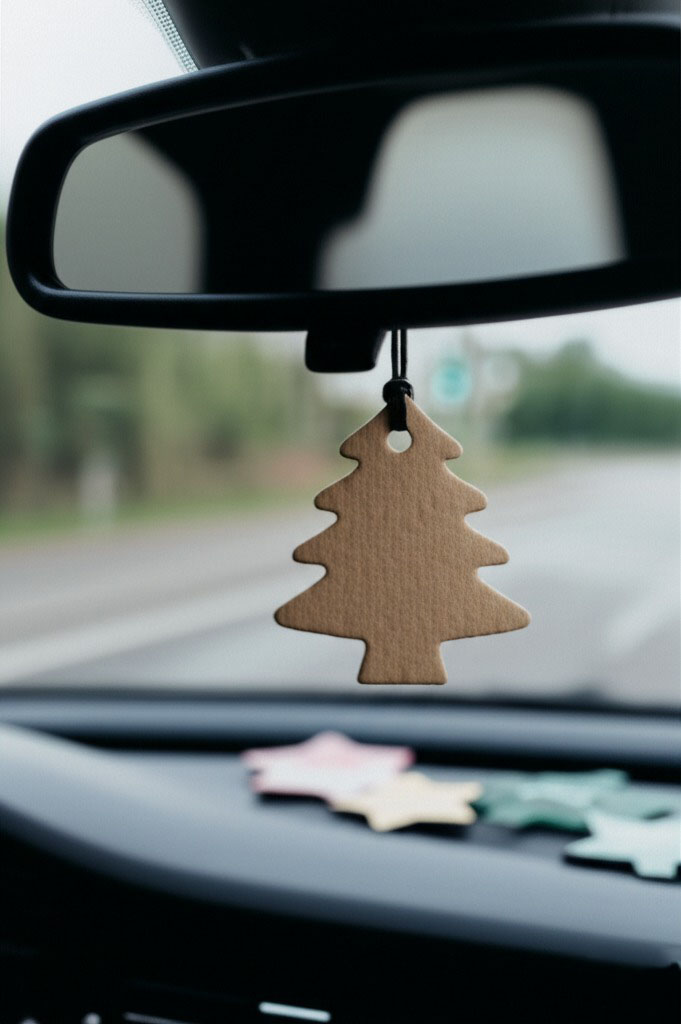
Clip-On Vent Freshener Styles
Easy to use: just clip onto your car’s dashboard grille.
Adjustable airflow: boost or mute the scent by turning vents.
Plastic designs blend in with your car’s interior style. Perfect for drivers who hate dangly bits on their mirror.
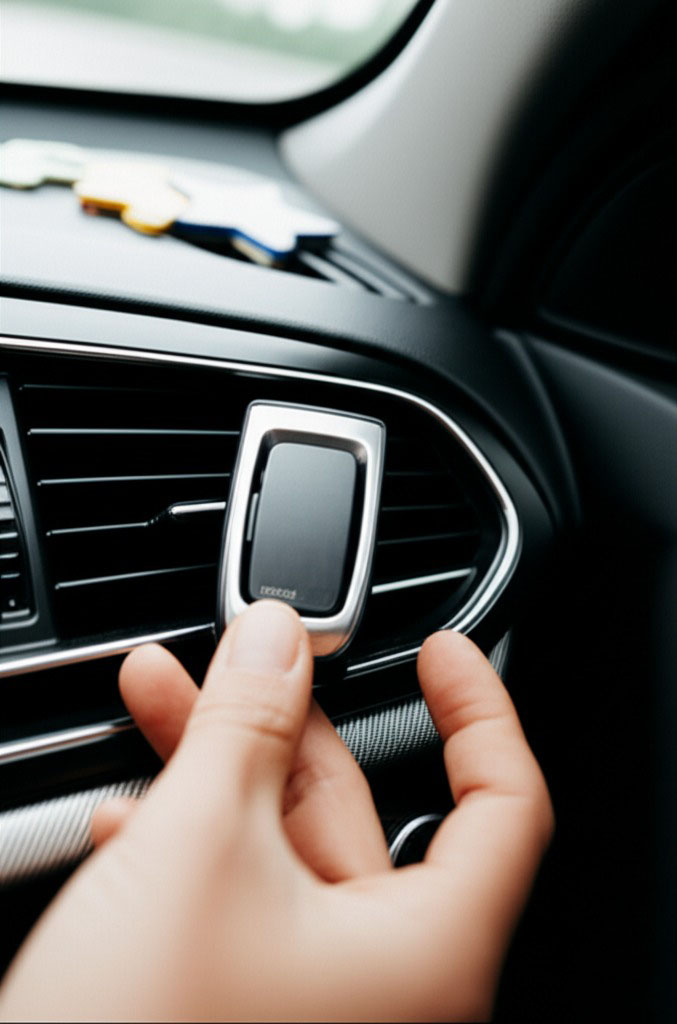
Liquid Gel Freshener Ideas
Pop a sealed gel container in your cup holder.
Twist lid to control how much fragrance fills the car.
Handy for long drives — the liquid slowly evaporates, tackling stubborn odors.
| Gel Type | Scent Strength | Duration (Weeks) |
|---|---|---|
| Citrus Gel | Medium | 4 |
| Lavender Gel | Strong | 5 |
| Ocean Breeze Gel | Mild | 3 |
Novelty Fresheners for Kids’ Cars
Novelty fresheners are a hit with kids — think cartoon animals or superhero shapes stuck to the dash. They’re fun, safe, and double as a cute decoration while freshening up the car air. Let the little ones pick their favourite character!

Which Scent Is Best for Cars?
Choosing the right car air freshener fragrance keeps your daily commute fresh without knocking you over with strong smells.
Popular Scents Drivers Love
Aussie drivers often stick with classics for their car air freshener. Favourites like new car aroma, vanilla bean, and citrus burst rank high because they mask odors without overpowering the vehicle interior. As auto expert L. Donnelly says, “A subtle scent keeps your dashboard vibe inviting, not suffocating.”
| Fragrance | Popularity (%) | Lasts (Weeks) |
|---|---|---|
| Vanilla Bean | 35% | 3 |
| Citrus Burst | 28% | 2 |
| New Car Aroma | 22% | 4 |
Scents That Neutralise Pet Odour
If you haul furry mates in your backseat, you’ll want a pet odor neutralizer that works double time.
Enzyme-Based Air Fresheners: Break down animal smells at the source.
Lavender & Green Tea: Natural, pet-friendly scents that deodorize gently.
Activated Charcoal Sachets: A no-fuss option to eliminate odor and keep the ride fresh.
Avoiding Overpowering or Clashing Smells
Mixing every fragrance under the sun? Nah, mate — keep it simple:
Mind Fragrance Layering: Don’t combine spicy and floral in a tight cabin.
Pick a Subtle Fragrance: Stick to a balanced scent profile to avoid olfactory fatigue.
Refresh Gently: A quick spritz beats drowning your car in overpowering smell.
For a harmonious scent, less is truly more.
Felt Freshener DIY Steps
Felt air fresheners are a top pick for DIY car lovers—customisable, affordable, and easy to make. This guide walks you through each step like a pro.
Choosing the Right Felt Fabric
Picking the right felt makes all the difference.
Wool felt absorbs essential oils best but costs more.
Acrylic felt is cheaper and colourful, but may not hold scent as long.
Aim for medium-thickness felt—around 2–3mm—for balance between flexibility and structure.
Stick with smooth, tightly woven felt for cleaner cutting.
Use darker colours for longevity; lighter ones can show stains quickly.
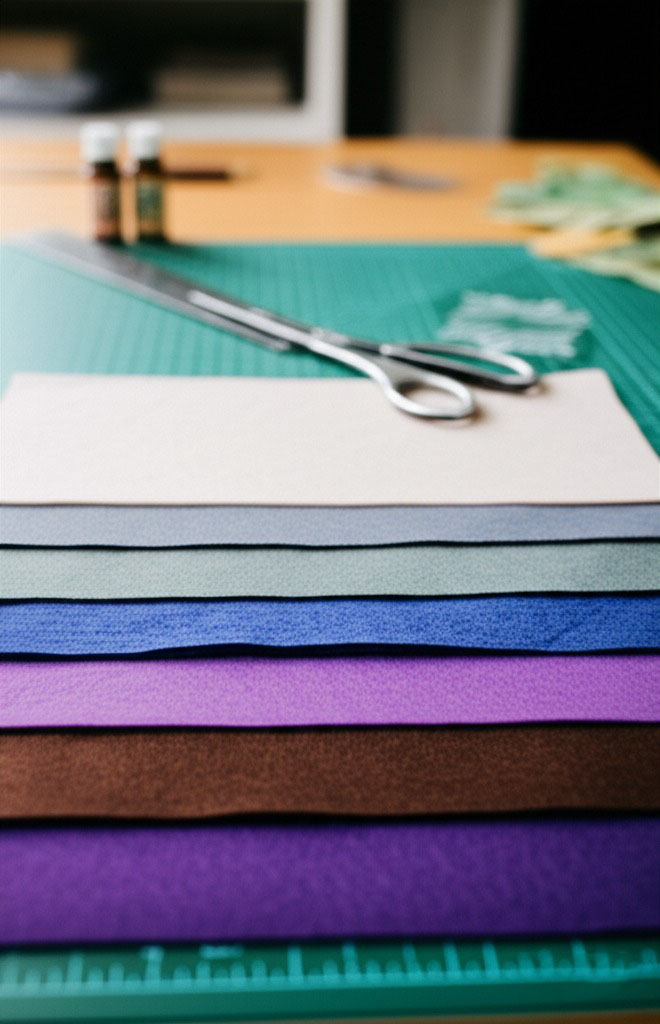
Cutting Templates and Fun Designs
Trace your design using a stencil or printable pattern.
Use sharp scissors or a craft knife for clean edges.
Want uniform shapes? Try a die cut machine.
Fun ideas: trees, stars, koalas, footy balls—go nuts with Aussie flair!
“The more creative the shape, the more likely you’ll want to keep it,” says local craft teacher Anna Reid.
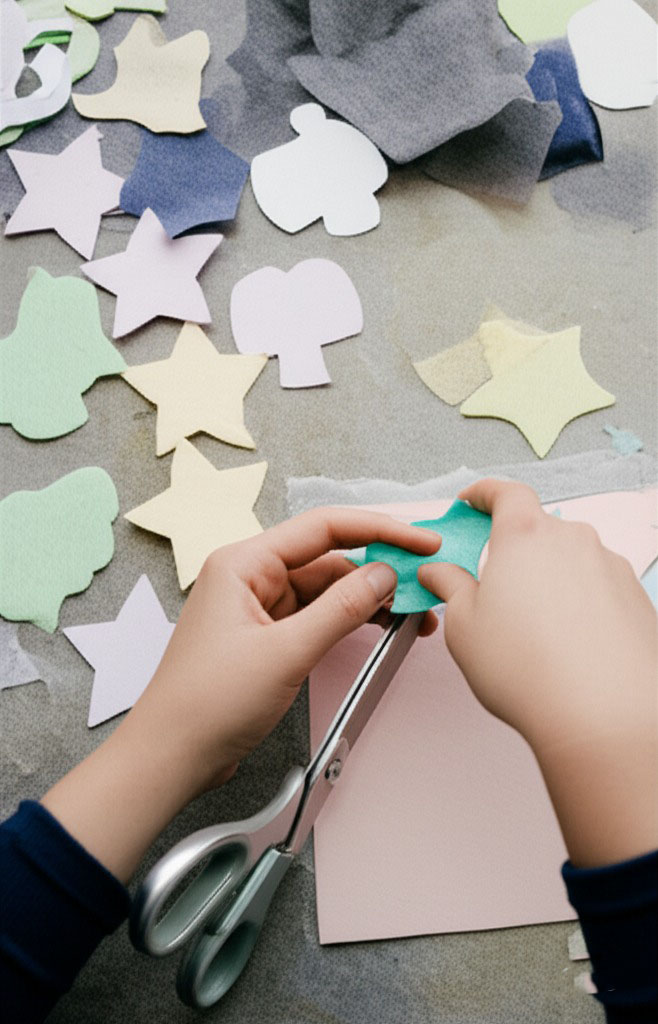
Adding Essential Oils to Felt
Drop 5–8 drops of your chosen essential oil directly onto the felt.
Best applied near the centre.
Allow time to soak—wool felt holds scent longer than synthetics.
For a stronger aroma, use a dropper instead of dabbing. Avoid overdoing it—strong oils like peppermint or eucalyptus can be overpowering in small spaces.
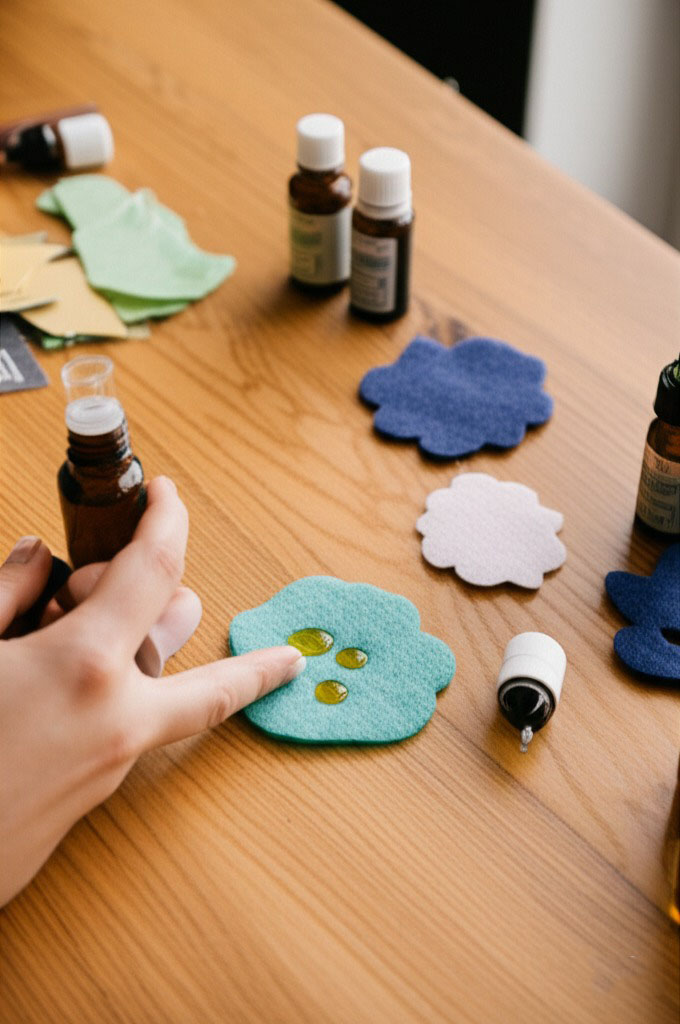
Hanging or Clipping Felt Safely
Hang it like a classic tree or clip it to your vent.
String or ribbon works best through a hole punch.
Use a mini bulldog clip to secure it to your sun visor or mirror.
Hot glue a pin backing to attach it to a fabric surface. Keep it away from airbag zones for safety!
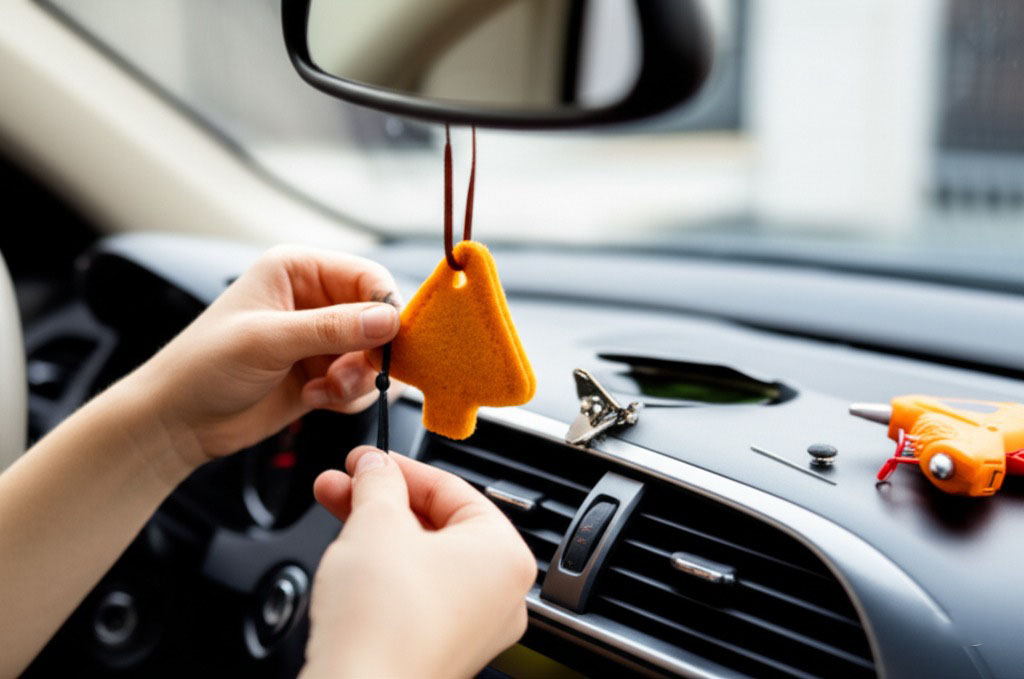
Reusing and Refreshing Felt Trees
No need to bin your felt tree once it fades.
Store them flat in a ziplock with a few drops of oil to recharge.
You can gently wash them in soapy water if they pick up dust.
Add seasonal decorations—like mini holly leaves in December—for extra charm.
Pro tip: Rotate between a few fresheners to keep scents from going stale.
✅ That’s the felt freshener method in a nutshell—cheap as chips, endlessly customisable, and fun for all ages. Keep it crafty and keep it fresh!
Mason Jar Freshener Guide
If you’re after a fresh-smelling ride without forking out for pricey commercial options, a mason jar air freshener is a dead-set winner—simple, natural, and lasts ages.
Baking Soda Scent Blend Ideas
Baking soda makes a brilliant base for absorbing smells and holding onto scent blends. For a homemade mix, stir together:
½ cup baking soda
20–25 drops of essential oil (e.g., lavender, eucalyptus, lemon)
Optional: 1 tsp dried herbs or citrus zest for added aroma
Popular natural scent combos:
| Blend Name | Essential Oils Used | Suggested Purpose |
|---|---|---|
| Aussie Bush | Eucalyptus + Tea Tree | Earthy & refreshing |
| Citrus Kick | Lemon + Grapefruit + Lime | Uplifting, energising |
| Sleepy Drive | Lavender + Chamomile | Calming, reduces stress |
Tip: Give the jar a gentle shake weekly to revive the scent.
Safe Jar Placement in Your Car
Let’s not muck around—chucking a jar on your dashboard isn’t the go. For a safe and tidy setup:
Use a non-slip mat on your cup holder or console tray.
Opt for jars with mesh lids or punch holes in a jar lid for slow release.
Avoid placing near airbags or vents, especially in hot weather—it’s not worth the risk.
Store jars upright and secure, ideally in cup holders, side-door pockets, or centre storage.
Quick Freshener Hacks
“People want fast fixes that actually work,” says Kelly Dawson, a vehicle detailer in Perth with over 15 years in the trade. “When someone drops by asking how to kill that fast food stink or gym bag whiff, I hand them a clothespin and some essential oils.” This no-fuss tip has earned Kelly a loyal local following. The trick? Dab a few drops of peppermint or lemon essential oil on a wooden clothespin and clip it to the air vent—instant diffuser 🌬️.
Other easy hacks from real Aussie drivers include:
Cotton balls with fabric softener sheets – placed under seats or in door pockets for a clean-laundry scent.
A cup of baking soda – tucked in a centre console cupholder to absorb nasty smells.
Coffee beans or ground espresso – great for smokers or fish’n’chip leftovers.
Activated charcoal in a breathable pouch – used by rideshare drivers to neutralise persistent odours.
Citrus peels and vinegar combo – stored in a small jar to give a zesty clean-up after muddy road trips.
Felt pads with essential oils – ideal for kids’ cars thanks to custom shapes and reusable scenting.
As noted in a recent Choice Australia review, natural odour absorbers like charcoal and baking soda outperform synthetic plug-ins when it comes to longevity and eco safety.
Real-world solutions from everyday drivers and pro detailers give these hacks their staying power. “Fast, cheap, no chemicals—what’s not to love?” Kelly adds.
Natural vs Chemical Freshener
Choosing between natural and chemical car air fresheners isn’t just about scent—it’s about safety, sustainability, and what you're breathing in every drive.
Chemical Ingredients to Watch Out For
Some store-bought fresheners are packed with nasties you don’t want fogging up your cabin. Keep an eye out for these big troublemakers:
Ammonia and Bleach – can irritate eyes and lungs.
Formaldehyde, Phosphates, and Petroleum distillates – linked to long-term health risks.
Synthetic Fragrances and Dyes – trigger allergies or asthma.
“Most people don’t realise the air in their car can be more polluted than outside,” says Emma Clark, an environmental chemist.
A quick check of the label might save your sinuses—and your seats.
Natural Oils Safe for Cars
Going natural doesn’t mean going soft. These ingredients clean, condition, and scent your ride like a pro:
Jojoba oil – great for leather seats, non-greasy finish.
Carnauba wax – protects exterior paint and smells fresh.
Coconut oil – nourishes rubber seals and adds a subtle scent.
Essential oils – ideal for felt or cotton fresheners; just a few drops do the trick.
Pro tip: Avoid over-oiling, especially on plastics or touchscreens. A tiny splash goes a long way.
Eco-Friendly Disposal Tips
Ready to chuck your DIY freshener? Hold up—there’s a better way.
Upcycle felt into drawer fresheners.
Recycle metal jar lids or plastic clips via local community programs.
Textile recycling accepts old fabrics if they’re scent-free.
Hazardous waste bins are the go for anything with lingering chemicals.
| Disposal Method | Item Type | Sustainability Score (/10) |
|---|---|---|
| Textile Recycling | Felt, cloth scraps | 9 |
| Plastic Recycling | Jar lids, containers | 7 |
| Upcycling | Cotton, wool, felt | 10 |
Taking the extra step means you’re not just freshening your car—you’re helping the planet stay fresh too.
How Long Do DIY Fresheners Last?
DIY fresheners don’t last forever. Here’s how to tell when they’re done, what affects their strength, and how to keep your car smelling ace for longer.
Average Lifespan of Felt Fresheners
Most felt air fresheners last around 2–3 weeks, depending on usage and scent type.
Light scents (like citrus) fade faster
Stronger oils (like patchouli) last longer Tip: Reapply oil weekly to stretch the aroma life.
Lifespan of Mason Jar Fresheners
Baking soda-based mason jar fresheners generally hold their scent for 3–4 weeks, but sealing the jar when not in use helps preserve the aroma.
| Material | Typical Lifespan | Notes |
|---|---|---|
| Baking soda | 3–4 weeks | Replace when scent fades |
| Essential oil | Varies by type | Reapply 10–15 drops weekly |
| Fabric lid | Helps diffuse | Choose breathable fabric |
Refreshing Old Essential Oil Blends
If your old essential oil blend smells more like a wet dog than a day spa, it’s time for a refresh.
Dilute: Mix 5–10 drops of essential oil with a splash of carrier oil.
Revive: Use this new blend in your felt or jar setup.
Test: If it still smells off—bin it and start fresh!
Keeping Jars Sealed When Parked
Open jars left in hot cars = wasted scent. ✅ Tighten the lid when the car’s off ✅ Store in shaded areas to reduce evaporation ✅ Use jars with rubber seals to lock in aroma Bonus tip: Pop the jar under your seat when parked for best results.
How Weather Affects Scent Strength
Scorching days or humid weather mess with how well your scent sticks around.
High heat = faster evaporation
Cold = slower diffusion
Humidity = muddled aroma “As temps rise, essential oils break down quicker,” notes Olivia Tran, scent chemist at The Fragrance Lab.
When to Replace Your DIY Freshener
You'll know it's time to replace your DIY freshener when:
The scent is barely noticeable
The fabric or felt feels dry
You’ve topped up three times and still smell nothing Swap it out, mate—your nose will thank you.
Buy or Make: Which Is Better?
“I used to grab those cheap pine tree fresheners at the servo every month,” recalls Melanie Tran, a rideshare driver in Melbourne. “Then I tried making my own with essential oils and baking soda. My car has never smelled fresher — and it actually lasts longer.” Her experience echoes what many drivers are now questioning: is DIY the smarter choice?
We spoke with James Cartwright, a chemical safety officer and consultant to several auto care brands. “Commercial air fresheners often contain phthalates and artificial musks that can trigger headaches,” he says. “DIY gives you control over ingredients, which is critical for families and asthma sufferers.”

💡 Here is how both options stack up:
Cost: DIY setups start under $5. Store-bought can go up to $20 monthly.
Convenience: Store options are fast, but DIY takes under 10 minutes to prep.
Customization: DIY allows endless scent blends. Pre-made choices are limited.
Safety: Homemade avoids harsh synthetics. Experts urge checking labels on commercial products.
Environmental Impact: DIY produces less waste; store-bought often includes plastic and foil.
Durability: Felt or mason jar fresheners can be refreshed for weeks. Disposable ones fade quickly.
Consumer watchdog CHOICE has tested dozens of air fresheners, with results showing many commercial ones degrade in scent within three days. When it comes to longevity, safety, and personal flair, DIY air fresheners come out on top.
Conclusion
“A calming scent can shift your whole mood,” says aromatherapist Tanya Hill. And she’s spot on — especially in peak-hour traffic.
The classic felt “tree” is hands down the simplest. Cut out a shape, add a few drops of your favourite essential oil, and hang it from your rearview mirror. Cheap, quick and does the job.
A few tricks to stretch that fresh scent:
Little habits like these can buy you a few extra weeks of freshness.
Use high-quality, pure essential oils — cheap ones fade fast.
Store spare fresheners in a sealed zip-lock bag until needed.
If using jars, keep the lid on tight when parked for long hours.
Most common oils are fine in small doses — think lavender, lemon, peppermint or eucalyptus. Just avoid pouring too much on fabrics as oils can stain or get too strong in a small cabin.
Yep! Once the scent fades, just add a few fresh drops of oil and you’re back in business. Some people even switch oils each month to match the season or their mood.
Some store-bought fresheners can contain volatile organic compounds (VOCs) that may irritate sensitive noses or cause headaches. Going natural with oils and baking soda means you skip all that nastiness.
Honestly? Cotton balls in a jar or cupholder:
Costs next to nothing and works a treat.
Pop a few cotton balls in a small jar.
Add 10–15 drops of essential oil.
Replace or top up weekly.
Always refresh sooner if the scent gets faint or your car starts smelling musty.
Felt trees: every 3–4 weeks
Mason jars: every 4–6 weeks (just stir or shake to revive)
Store-bought gels: check expiry but usually 30–60 days
DIY fresheners mostly mask odours, but some combos (like baking soda + lemon oil) can absorb mild smells too. If your car’s pongy, best fix the source first — crumbs, spills, or a wet floor mat are usually the culprits!

Leave a comment